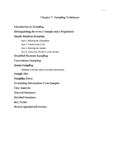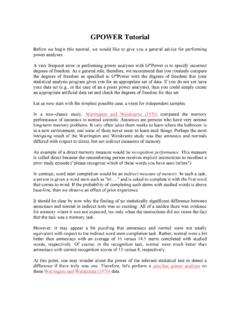Transcription of Diversity and inclusion: What’s it about and why is …
1 Diversity and inclusion : what s it about and why is it important for public involvement in research?This paper is about Diversity and inclusion for active public involvement in research. In the paper we highlight why it is important to think about including the perspectives of a wide range of people and groups in research and the main barriers to involving ideas on how to involve a diverse range of people in research, please refer to the Briefing notes for researchers and the supplement Strategies for Diversity and inclusion in public involvement what do we mean by the terms Diversity and inclusion ?
2 22. Why is it important to think about Diversity and inclusion for active public involvement in research? ..33. Who are we talking about ? ..44. what are the common barriers to Diversity and inclusion ? ..85. How can we overcome these barriers? ..126. Find out more about Diversity and inclusion ..15 References ..15 Appendix 1: The Equality Act 2010 ..17 Appendix 2: The Mental Capacity Act 2005 and its application to what do we mean by the terms Diversity and inclusion ?When we talk about Diversity we mean respecting and valuing all forms of difference in individuals. People differ in all sorts of ways which may not always be obvious or visible.
3 These differences might include race and ethnicity, culture and belief, gender and sexuality, age and social status, ability and use of health and social care services. Below are some of the differences in the 61 million people who made up the UK population in 2007:n 16% were aged over 61 yearsn 90% were White British; in London this was 65%n 19% had a long term illness or disability n 77% identified with a religion (72% Christian, 3% Muslim, 1% Hindu and 1% other religions)n an estimated 5-7% were lesbian, gay or bisexual(Source: British Council )It is recognised that some people and groups, because of a range of differences, find it more difficult to have their voice heard in mainstream society - their views, needs and perspectives may not be routinely taken into account, for example in planning services or undertaking research.
4 inclusion is about positively striving to meet the needs of different people and taking deliberate action to create environments where everyone feels respected and able to achieve their full phrase often used in this context is equality of opportunity, meaning how we can ensure the full range of relevant people and groups have similar access to opportunities. This might be access to employment opportunities, access to services and civil society or, where our interest lies, in ensuring equal access to the opportunities to get involved in research. The Equality Act 2010 includes certain duties to actively promote equality of opportunity for some groups (see Appendix 1 for a summary of the Act).
5 This legal framework applies mainly to public authorities, for example an NHS Trust or a university. So while it may not be necessary for research groups and those working on individual research projects to meet specific legal requirements about Diversity and inclusion , it is still good practice to think about the issues raised, as highlighted by the Research Governance Framework (see below).The Research Governance Framework (2nd edition, 2005) states: Research, and those pursuing it, should respect the Diversity of human society and conditions and the multicultural nature of society. Whenever relevant, it should take account of age, disability, gender, sexual orientation, race, culture and religion in its design, undertaking, and reporting.
6 The body of research evidence available to policy makers should reflect the Diversity of the population. (paragraph , page 8) Research [should be] pursued with the active involvement of service users and carers including where appropriate, those from hard to reach groups such as the homeless. (Box B: Standards in quality organisations undertaking research: Ethics, page 16).Available to download from the Department of Health website 22. Why is it important to think about Diversity and inclusion for active public involvement in research?The extent of public involvement in research has grown hugely over the past 15 years, with much greater levels of activity than ever before.
7 However, while there is greater public involvement taking place, there is concern that the people getting involved with research do not always reflect the Diversity of the population as described above. As researchers and research organisations begin to actively involve people in research, we often find that those getting involved are the people who are the easiest to involve. By this we mean people who are used to being involved, with an existing connection with the organisation, who are able to volunteer their time and energy, and who understand how organisations, such as research institutes, this is often a really good starting point both for the researchers and the involved members of the public we should recognise the limitations of this approach.
8 It can mean that the same types of people, sometimes referred to as the usual suspects , have access to the opportunities to get involved, rather than a wider pool of people. We do not have detailed information on who is getting involved in research (yet!), but data from other arenas of public participation shows that those getting involved in public life are more likely to be older, from white ethnic groups and higher socio-economic backgrounds (Pathways through participation, 2009). While these people often develop useful skills and become experienced in active involvement, they come from a relatively narrow section of the population, and may have a limited range of experiences and perspectives to draw upon.
9 People who use NHS and social care services, or who are the target of public health initiatives, encompass a wide range of differences across the population. It is well established that some parts of the population experience greater ill health, disability and reduced life expectancy than others (Black, 1980). Inequalities by ethnic group and gender, for example, can be demonstrated across a wide range of measures of health (Acheson, 1998). In 2010, the Marmot Review concluded that health inequalities are a result of social and economic inequalities across the population - put simply, the higher one s social position, the better one s health is likely to be (Marmot 2010, page 10).
10 Example: Diabetes and South Asian and African Caribbean peoplePeople from South Asian and African Caribbean communities are two to six times more likely to develop Type 2 Diabetes than the white European population yet some of these communities rarely participate in National Institute for Health Research (NIHR) Diabetes Research Network attended the Baishakhi Mela (celebrating the Bangladeshi New Year) in the Brick Lane area of East London. Over 100,000 people attended from across London and the South East. Network staff offered blood glucose checks and ran a survey. The survey asked about people s awareness of diabetes, their attitudes to clinical research and any cultural or religious barriers to taking part in research.









